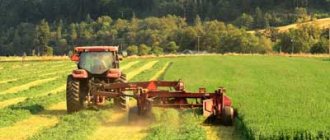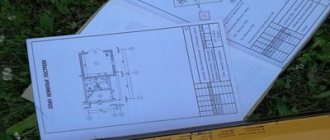Home / Real estate / Land / Size of land
Back
Published: 11/16/2017
Reading time: 8 min
0
769
When forming land for private household plots, peasant farms and agriculture, it is necessary to take into account the maximum size of plots. Such sizes are determined either by the law of the subject or by order of the local administration. Failure to comply with the established plot sizes will result in the impossibility of registering the land in the cadastral register.
- Legislation on sizes
- Limit sizes for private household plots, peasant farms and agriculture Minimum parameters
- Maximum parameters
Registration of a land share in ownership: features of the procedure
All land shares have already been transferred to the ownership of citizens and legal entities free of charge. Each participant in common property has a plot of land ranging from one to several hectares, and this is a very impressive area.
To register a share, you need to contact Rosreestr with a land allotment document. Basically, everyone who wishes has already registered their shares and received certificates of ownership. It indicates the area that an individual shareholder can claim, the cadastral number of the entire plot and the area of the entire plot, from which a share can subsequently be allocated.
After the owner of the share has formalized his right, he can make transactions in the manner provided for in Art. 12 of Federal Law No. 101-FZ of July 24, 2002. You can dispose of the share at your own discretion, like any other piece of real estate: donate, sell, inherit, lease.
Link to document: “On the turnover of agricultural land”
Link to document:
Legislation on sizes
Each newly formed plot of land, regardless of the established type of intended use, has certain parameters, the dimensions of which must comply with the standards established by law.
The area of the created plot of land, which provides for the maintenance of personal subsidiary plots (LPH), peasant (farm) holdings (peasant farms) or agricultural production (Agricultural production) should not exceed or be less than the permissible area.
The maximum sizes defined in the legislation allow not only to avoid the fragmentation of land into small plots, but will also help prevent the accumulation of a large number of hectares of land in the hands of one landowner.
The maximum and minimum parameters of land plots are regulated by the Land Code and the Town Planning Code of the Russian Federation , as well as the laws of the subjects and regulations of local governments.
The Town Planning Code provides for the establishment of limit parameters in regulations (town planning), which include rules for land use of the relevant territory and its development (LZ).
The maximum sizes of land plots for which such regulations have not been established are regulated by legislation at the level of the subject or local government, depending on the type of intended use of the site.
You can find out the maximum dimensions allowed when forming a land plot on the official website of the local administration in the “Urban planning documentation” (regulatory acts such as master plans and land plots should be publicly available).
How to determine the cost of appraising an apartment for a mortgage? You will learn how to allocate a share from common property in our feature article.
You can find out how to take the extract you need from the house register in the material at the link.
Transactions with land shares
To sell, donate or leave a share as an inheritance, it is not necessary to allocate it in kind.
- Sale . When selling a share, the co-owners of the plot that includes the share have the first right of purchase. Therefore, it is initially necessary to notify them in writing of the intention to sell the share with a price indication. The letter must have a return receipt. If they do not express a desire to buy the alienated share within 30 days, then the share can be sold to any person, but for a price not exceeding that which was offered to the co-owners.
- Inheritance . The heir to the share applies to Rosreestr with an inheritance certificate from a notary. The state fee for transferring the right is 350 rubles; no accompanying documents are required.
- Giving . To donate a share, the donor and recipient must register the gift agreement with Rosreestr. There is no need to notify co-owners of the gift transaction.
The concept of status and general characteristics of plots
Let's consider the general characteristics of such lands and their importance in meeting the needs of future owners.
According to Art. 77 of the Land Code of the Russian Federation, land plots are recognized as agricultural if they are located outside the city and are used for agricultural needs. Such lands include:
- fields for growing agricultural crops;
- roads;
- forest plantations;
- ponds;
- buildings for the production, storage and primary processing of grain, vegetables or fruits.
Lands can be used:
- for farming business;
- for personal farming;
- summer cottage construction;
- livestock farming;
- haymaking and grazing;
- scientific research;
- gardening activities.
The use of the plots is also permitted for hunting. Particularly valuable land, the cadastral value of which significantly exceeds the average level of district cadastral value, can be included in the list of lands, the use of which for other purposes is not allowed (how is the cadastral value of land plots calculated?).
The owner of these lands has the right of ownership to all crops and plantings, the resulting products and income from their sale.
Important! There are a number of restrictions for agricultural land. They are mainly purchased by farms and agricultural enterprises that plan to use them exclusively for agricultural purposes.
A complete description of agricultural land and information on the types of its permitted use can be found here.
Share allocation in kind
This is where the fun begins. Where is this share actually? How to highlight it in kind in 2021, given that most of the suitable places are already occupied by other users?
The procedure for allotment in kind is subject to the norms for the formation of plots and occurs in accordance with the Land Code of the Russian Federation and Federal Law No. 101-FZ.
Stages of share allocation:
- To exercise the right to allocate a share in kind, the first step is to select a place where it can be located. Perhaps this will be the most important and most difficult part of the procedure.
It is necessary to select a site based on data from contour sheets (they can be requested from the Rosreestr Office) and other cartographic material that contains information about the location of the former agricultural enterprise.
Only if no graphical data exists can you search for a suitable location on the Public Cadastral Map in the area where the site is located. It is very important to correctly form the site within the boundaries: it should not be occupied by farmland, on-farm roads, communications that belong to the property of the constituent entities of the Russian Federation. The formed area should not be located outside the boundaries of cultivated farmland. The choice of a place where it is possible to form a plot of agricultural land should be approached very responsibly. It happens that even the authorities make claims against areas allocated and registered within the boundaries, for example, if the formed area has taken over a forest belt. The authorized authority has the right to sue the owner of such a plot.
- When a suitable location has been found, you need to prepare a land surveying project. This is what cadastral engineers do.
- The next mandatory stage of the process is the publication of a notice about the allocation of a share in kind: the cadastral number of the plot from which the allocation is being made, the owner’s full name, and address are indicated. With this notification, co-owners are notified that it is necessary to familiarize themselves with the location of the allocated plot and agree on it. To submit justified objections to the address indicated in the publication, the law allows 30 days.
The notice is submitted to the local newspaper, which publishes official information by local government bodies. This procedure is regulated by clauses 10-14 of Art. 13.1 No. 101-FZ.
If the remaining participants in shared ownership have not contacted the cadastral engineer, you can proceed to the next stage.
- If there are no objections, the land surveying project is considered agreed upon and certified by the owner of the share.
- A boundary plan is prepared, which includes a graphic part that establishes the exact location of the allocated farmland. The land surveying project is an integral part of the land survey plan, the newspaper is an appendix to it.
If there are less than 6 co-owners, you will additionally need an agreement on allotment, or a copy of the minutes of the general meeting of co-owners certified by a representative of the administration. This provision is provided for by Federal Law No. 218-FZ of July 13, 2015 “On State Registration of Real Estate”.
- The boundary plan is submitted to Rosreestr for registration of the share as an independent object and the emergence of the right to the formed plot. The right to a share in the common plot is canceled. An owner who wishes to carry out a spin-off has the right to submit an application to Rosreestr without co-owners.
After the allocation of the share in kind, the owner of the share will become the full owner of the plot formed within the boundaries. It will become even easier to manage such a plot, it can be easily rented out, and its value will increase.
If the owners of the land plot do not come to an agreement, you can go to court for the allocation of your share (Article 252 of the Civil Code of the Russian Federation).
The cost of work on allocating a plot, due to its complexity and duration, as well as the large size of the plot, is several times higher than the work on surveying ordinary plots of individual housing construction and gardens. If Rosreestr denies the formation of a plot due to its location outside the boundaries of farmland, the cadastral work will have to be redone and the publication resubmitted, which entails additional time and material costs.
Agricultural lands are lands located outside the boundaries of a populated area and provided for agricultural needs, as well as those intended for these purposes.
Citizens, legal entities, the Russian Federation, constituent entities of the Russian Federation, and municipalities can own agricultural land plots. Foreign citizens, foreign legal entities, stateless persons, as well as legal entities in the authorized (share) capital of which the share of foreign citizens, foreign legal entities, stateless persons is more than 50 percent, may possess such land plots only on a lease basis. Thus, current legislation excludes the possibility of transferring ownership of an agricultural land plot to a foreign legal entity. Agricultural lands can be used, inter alia, for agricultural production, the creation of protective forest plantations, research, educational and other purposes related to agricultural production, for aquaculture (fish farming), and for carrying out activities in the field of hunting. In accordance with the Law on Land Turnover, the turnover of agricultural land is based on the following principles: 1) maintaining the intended use of land plots; 2) establishing the maximum size of the total area of agricultural land, which is located on the territory of one municipal district and can be owned by one citizen and (or) one legal entity; 3) the preemptive right of a subject of the Russian Federation or, in cases established by the law of a subject of the Russian Federation, a municipal entity, to purchase a land plot of agricultural land upon its sale, with the exception of cases of sale at public auction; 4) the preemptive right of other participants in shared ownership of a land plot that is in shared ownership, or using this land plot of an agricultural organization or a citizen - member of a peasant (farm) enterprise to purchase a share in the right of common ownership of a land plot of agricultural land in case of paid alienation such share by a participant in shared ownership; 5) establishing the specifics of providing land plots from agricultural lands to foreign citizens, foreign legal entities, stateless persons, as well as legal entities in whose authorized (share) capital the share of foreign citizens, foreign legal entities, stateless persons is more than 50 percent . At the same time, the ownership, use and disposal of a land plot owned by 5 or more participants is carried out in accordance with the decision of the participants in shared ownership, which is adopted at a general meeting of participants in shared ownership. By virtue of the Law on Land Turnover, a constituent entity of the Russian Federation or in accordance with the law of a constituent entity of the Russian Federation, a municipal entity has a preemptive right to purchase a land plot from agricultural lands (except for cases of sale at public auction and cases of withdrawal of a land plot for state or municipal needs). The seller of a land plot is obliged, in accordance with the established procedure, to notify the highest executive body of state power of a constituent entity of the Russian Federation or, in cases established by the law of a constituent entity of the Russian Federation, a local government body of the intention to sell the land plot, indicating the essential terms of such an agreement. At the same time, the period for making mutual settlements for such transactions cannot be more than ninety days. If a subject of the Russian Federation or, in accordance with the law of a subject of the Russian Federation, a municipal entity refuses to purchase or does not notify the seller in writing of its intention to purchase a land plot within thirty days from the date of receipt of the notice, the seller has the right to sell the land plot to a third party within a year at a price not lower than that stated in the notice. Failure to comply with the preferential rights of these entities leads to the recognition of such a transaction as void. The Land Turnover Law does not apply to garden, vegetable, and dacha land plots related to agricultural lands, land plots intended for personal subsidiary plots, garage construction (including individual garage construction), as well as land plots on which real estate objects are located. The turnover of these land plots is regulated by the Land Code of the Russian Federation. The Law on Land Turnover establishes the maximum size of the total area of agricultural land, which is located on the territory of one municipal district and can be owned by one citizen and (or) one legal entity - this size is established by the law of the subject of the Russian Federation equal to no less than 10 percent of the total area of agricultural land. lands located on the specified territory at the time of provision and (or) acquisition of such land plots. There is also a restriction on the right of ownership in relation to foreign citizens, foreign legal entities, stateless persons, as well as legal entities in the authorized (share) capital of which the share of foreign citizens, foreign legal entities, stateless persons is more than 50 percent - these persons may possess land plots from agricultural lands only on a lease basis. Land plots from agricultural lands that have undergone state cadastral registration in the prescribed manner can be leased. A lease agreement for a land plot in state or municipal ownership is concluded for a period of three to forty-nine years. At the same time, the lease agreement for a land plot may provide that the leased land plot is transferred into the ownership of the tenant upon expiration of the lease period or before its expiration, subject to the payment by the tenant of the entire redemption price stipulated by the agreement. Unless otherwise provided by law or the lease agreement, the tenant who has duly performed his duties, upon expiration of the lease agreement, has, other things being equal, a preferential right to conclude a lease agreement for a new term. A land lease agreement is subject to state registration in the prescribed manner. Article 8 of the Land Code of the Russian Federation determines that the transfer of land from one category to another is carried out in relation to: 1) lands in federal ownership - by the Government of the Russian Federation; 2) lands owned by constituent entities of the Russian Federation and agricultural lands owned by municipalities - by executive authorities of constituent entities of the Russian Federation; 3) lands in municipal ownership, with the exception of agricultural lands, by local government bodies; 4) privately owned lands: agricultural lands - by executive authorities of the constituent entities of the Russian Federation; lands for other special purposes - by local government bodies. The composition and procedure for preparing documents for the transfer of lands or land plots within such lands from one category to another are determined by the Law on Land Transfer. At the same time, Article 7 of the Law on Land Transfer establishes the specifics of transferring agricultural lands to lands of other categories. The transfer of agricultural lands or land plots as part of such lands is permitted in exceptional cases related to: 1) land conservation; 2) with the creation of specially protected natural areas or with the classification of lands as lands of environmental, historical, cultural, recreational and other particularly valuable purposes; 3) with the establishment or change of the boundaries of populated areas; 4) with the placement of industrial facilities on lands, the cadastral value of which does not exceed the average level of cadastral value for the municipal district (urban district), as well as on other lands and with other non-agricultural needs in the absence of other options for the location of these facilities, 5) with the inclusion of unsuitable for carrying out agricultural production of lands included in forest fund lands, water fund lands or reserve lands; 6) with the construction of roads, power lines, communication lines (including linear cable structures), oil pipelines, gas pipelines and other pipelines, railway lines and other similar structures (hereinafter referred to as linear objects) in the presence of a project for the reclamation of part of agricultural land approved in the prescribed manner land provided for the period of construction of linear facilities; 7) with the fulfillment of the international obligations of the Russian Federation, ensuring the defense of the country and the security of the state in the absence of other options for the placement of relevant facilities; with mining operations in the presence of an approved land reclamation project; 9) with the placement of social, public utility, healthcare, and educational facilities in the absence of other options for the placement of these facilities. The transfer of agricultural lands or land plots as part of such lands from agricultural lands, the cadastral value of which is fifty percent or more higher than the average level of cadastral value for the municipal district (urban district), and especially valuable productive agricultural land to another category is not allowed. Article 2 of the Law on Land Transfer establishes that in order to transfer lands or land plots as part of such lands from one category to another, an interested person submits a corresponding petition to the executive body of state power or local government body authorized to consider this petition. The content of such a petition is established by the relevant government body or local government body. The application indicates: 1) cadastral number of the land plot; 2) the category of land, which includes the land plot, and the category of land, the transfer to which is supposed to be carried out; 3) justification for the transfer of a land plot from one category of land to another; 4) rights to a land plot. The list of documents required to make a decision on the transfer of land plots from one category of land to another is established by the Law on Land Transfer. Based on the results of consideration of the application, the executive body of state power or local government body adopts an act on the transfer of lands or land plots as part of such lands from one category to another or an act on refusal to transfer lands or land plots as part of such lands from one category to another to the following terms: 1) within three months from the date of receipt of the application, unless otherwise established by regulatory legal acts of the Russian Federation, - by the Government of the Russian Federation; 2) within two months from the date of receipt of the application - by the executive body of state power of a constituent entity of the Russian Federation or a local government body. An act on the transfer of lands or land plots or an act on refusal to transfer lands or land plots may be appealed in court.
Let's sum it up
A special feature of the procedure for registering land shares is the difficulty in realizing the right to actually use a plot without allocating it in kind. At the same time, a virtual share can be sold, bequeathed, donated, or left as an inheritance. At the moment, all land shares have already been transferred into the ownership of citizens and legal entities; they are the same subject of turnover as any other property. When selling an unallocated share, the remaining shareholders have the right of first refusal.
The allocation of a share in kind is carried out on the basis of a land surveying project and a land survey plan.
Read: Changes when registering a house on a garden plot in 2021
Features of use
Private individuals
On agricultural lands, individuals have the right to carry out only activities specified by the Land Code of the Russian Federation. This is about:
- Farming.
- LPH.
- Haymaking.
- Vegetable gardening.
- Cattle grazing.
- Fish farming, etc.
Objects of land legal relations of individuals:
- land;
- land shares;
- rights for land shares and land plots.
Land can be bought and sold (with mandatory notification to government agencies), leased and subleased, as well as transferred as a gift, inheritance, or the authorized capital of a joint-stock company. Individuals have equal rights with legal entities in the use and opportunity to buy and sell land. Restrictions exist only for foreign individuals who do not have the right to acquire agricultural arable land as their property.
Commercial organizations
Plots of agricultural land can be purchased, leased and used by any commercial organization. All lands used by commercial organizations have a special legal status as land users of agricultural lands.
Types of agricultural organizations:
- production or consumer cooperatives;
- peasant (farm) farms.
Different agricultural organizations may have their own legal regime. For example, for farmers, minimum sizes of land plots are not established if their activity profile is: gardening, greenhouse vegetable growing, viticulture, seed farming, poultry farming, beekeeping, commercial fish farming or other activities important for the development of agriculture in the region.
Agricultural organizations may be provided with land for ownership, permanent use or lease. If an allotment is granted, members of cooperatives receive the right to a land share. Unclaimed land shares become state property.
Important! In addition to commercial associations, land plots are also provided for ownership by religious organizations, scientific institutes and Cossack societies (non-profit organizations).
Cooperatives
Cooperatives have the right to buy and sell agricultural land. According to the Law “On Agricultural Cooperation,” cooperative transactions for the alienation and acquisition of land plots are carried out only with the consent of the general meeting of all members (Article 38).
Participants may, for a certain period not exceeding 10 years, be required to sell the agricultural products they produce, or part of them, to the cooperative and not to other organizations.
Enterprises
(JSC, LLC and other forms of ownership) also have the right to use agricultural land These can be agricultural farms, breeding and stud farms, enterprises for the reproduction of valuable fish species and other companies.
The acquisition and sale of plots for enterprises follows the same principles: the land can only be used for agricultural purposes and before selling the plot it must first be offered to local authorities, who have priority rights to purchase.
To complete the transaction, you will need to show a power of attorney from the representative or confirm the authority of the director of the company. If permission from the founders is required to sign an agreement under the company’s Charter, then this document will also need to be provided.









